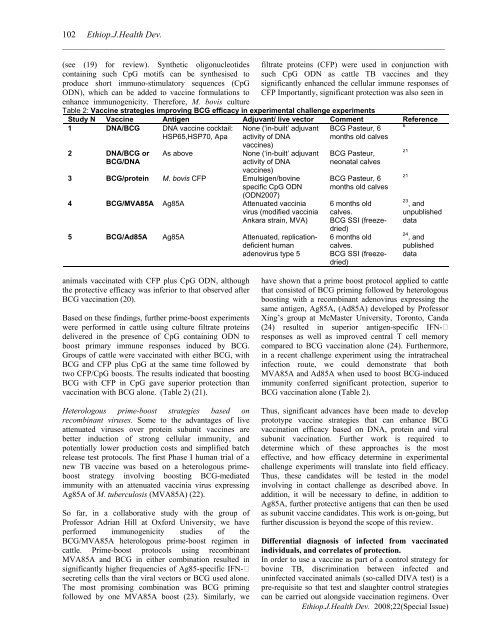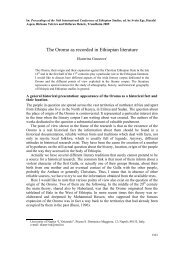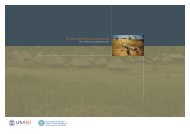You also want an ePaper? Increase the reach of your titles
YUMPU automatically turns print PDFs into web optimized ePapers that Google loves.
102 Ethiop.J.Health Dev.<br />
______________________________________________________________________________________<br />
(see (19) for review). Synthetic oligonucleotides<br />
containing such CpG motifs can be synthesised to<br />
produce short immuno-stimulatory sequences (CpG<br />
ODN), which can be added to vaccine formulations to<br />
enhance immunogenicity. Therefore, M. bovis culture<br />
filtrate proteins (CFP) were used in conjunction with<br />
such CpG ODN as cattle TB vaccines and they<br />
significantly enhanced the cellular immune responses of<br />
CFP Importantly, significant protection was also seen in<br />
Table 2: Vaccine strategies improving BCG efficacy in experimental challenge experiments<br />
Study N Vaccine Antigen Adjuvant/ live vector Comment Reference<br />
1 DNA/BCG DNA vaccine cocktail: None (‘in-built’ adjuvant BCG Pasteur, 6<br />
6<br />
HSP65,HSP70, Apa activity of DNA<br />
months old calves<br />
vaccines)<br />
2 DNA/BCG or As above None (‘in-built’ adjuvant BCG Pasteur,<br />
21<br />
BCG/DNA<br />
activity of DNA<br />
neonatal calves<br />
vaccines)<br />
3 BCG/protein M. bovis CFP Emulsigen/bovine BCG Pasteur, 6<br />
21<br />
specific CpG ODN months old calves<br />
(ODN2007)<br />
4 BCG/MVA85A Ag85A Attenuated vaccinia 6 months old<br />
23<br />
, and<br />
virus (modified vaccinia calves.<br />
unpublished<br />
Ankara strain, MVA) BCG SSI (freeze- data<br />
dried)<br />
5 BCG/Ad85A Ag85A Attenuated, replication- 6 months old<br />
24<br />
, and<br />
deficient human calves.<br />
published<br />
adenovirus type 5 BCG SSI (freezedried)<br />
data<br />
animals vaccinated with CFP plus CpG ODN, although<br />
the protective efficacy was inferior to that observed after<br />
BCG vaccination (20).<br />
Based on these findings, further prime-boost experiments<br />
were performed in cattle using culture filtrate proteins<br />
delivered in the presence of CpG containing ODN to<br />
boost primary immune responses induced by BCG.<br />
Groups of cattle were vaccinated with either BCG, with<br />
BCG and CFP plus CpG at the same time followed by<br />
two CFP/CpG boosts. The results indicated that boosting<br />
BCG with CFP in CpG gave superior protection than<br />
vaccination with BCG alone. (Table 2) (21).<br />
Heterologous prime-boost strategies based on<br />
recombinant viruses. Some to the advantages of live<br />
attenuated viruses over protein subunit vaccines are<br />
better induction of strong cellular immunity, and<br />
potentially lower production costs and simplified batch<br />
release test protocols. The first Phase I human trial of a<br />
new TB vaccine was based on a heterologous primeboost<br />
strategy involving boosting BCG-mediated<br />
immunity with an attenuated vaccinia virus expressing<br />
Ag85A of M. tuberculosis (MVA85A) (22).<br />
So far, in a collaborative study with the group of<br />
Professor Adrian Hill at Oxford University, we have<br />
performed immunogenicity studies of the<br />
BCG/MVA85A heterologous prime-boost regimen in<br />
cattle. Prime-boost protocols using recombinant<br />
MVA85A and BCG in either combination resulted in<br />
significantly higher frequencies of Ag85-specific IFN-<br />
secreting cells than the viral vectors or BCG used alone.<br />
The most promising combination was BCG priming<br />
followed by one MVA85A boost (23). Similarly, we<br />
have shown that a prime boost protocol applied to cattle<br />
that consisted of BCG priming followed by heterologous<br />
boosting with a recombinant adenovirus expressing the<br />
same antigen, Ag85A, (Ad85A) developed by Professor<br />
Xing’s group at McMaster University, Toronto, Canda<br />
(24) resulted in superior antigen-specific IFN-<br />
responses as well as improved central T cell memory<br />
compared to BCG vaccination alone (24). Furthermore,<br />
in a recent challenge experiment using the intratracheal<br />
infection route, we could demonstrate that both<br />
MVA85A and Ad85A when used to boost BCG-induced<br />
immunity conferred significant protection, superior to<br />
BCG vaccination alone (Table 2).<br />
Thus, significant advances have been made to develop<br />
prototype vaccine strategies that can enhance BCG<br />
vaccination efficacy based on DNA, protein and viral<br />
subunit vaccination. Further work is required to<br />
determine which of these approaches is the most<br />
effective, and how efficacy determine in experimental<br />
challenge experiments will translate into field efficacy.<br />
Thus, these candidates will be tested in the model<br />
involving in contact challenge as described above. In<br />
addition, it will be necessary to define, in addition to<br />
Ag85A, further protective antigens that can then be used<br />
as subunit vaccine candidates. This work is on-going, but<br />
further discussion is beyond the scope of this review.<br />
Differential diagnosis of infected from vaccinated<br />
individuals, and correlates of protection.<br />
In order to use a vaccine as part of a control strategy for<br />
bovine TB, discrimination between infected and<br />
uninfected vaccinated animals (so-called DIVA test) is a<br />
pre-requisite so that test and slaughter control strategies<br />
can be carried out alongside vaccination regimens. Over<br />
Ethiop.J.Health Dev. <strong>2008</strong>;22(Special Issue)







